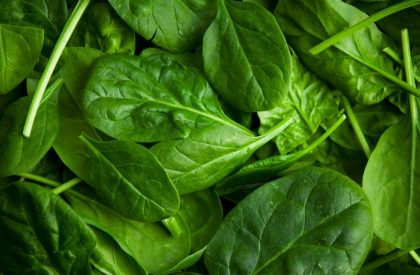Spinach
Spinach Nutrition: 10 Powerful Benefits Of This Green Veggie
Spinach is a super food. The leaves are replete with essential vitamins and minerals and other powerful antioxidants. The leafy green vegetable fights oxidative damage and associated ailments. It also helps combat cancer and may lower blood sugar levels (1).
In this post, we will explore the varied nutritional profile of spinach and its incredible benefits.
Table Of Contents
- What Is The Nutritional Profile Of Spinach?
- What Are The Health Benefits Of Spinach?
- How To Include Spinach In Your Diet
- How To Select And Store Spinach Leaves
- What Are The Possible Side Effects Of Spinach?

What Is The Nutritional Profile Of Spinach?
The most abundant nutrients in spinach include vitamins A, C, K1, and iron, folic acid, and calcium. It also contains potent antioxidants, including lutein, zeaxanthin, and quercetin. The following table will give you more insight into the nutrition profile of the leafy veggie.
What Are The Health Benefits Of Spinach?
Spinach is full of carotenoids that fight oxidative stress and cancer. The fiber it contains also promotes satiety and may help manage diabetes. Calcium promotes bone health, and lutein and zeaxanthin improve vision.
1. May Help Fight Cancer
The glycoglycerolipids in spinach have been found to help prevent cancer. They can achieve this by inhibiting tumor growth
The vitamin A in spinach can also cut the risk of breast cancer. Eating spinach (or carrots, which are also rich in vitamin A) more than twice a week has been linked to a modest decrease in breast cancer risk. Spinach is a cruciferous vegetable. Studies show that cruciferous veggies can play an important role in cancer prevention. These veggies are rich in carotenoids (like lutein and zeaxanthin) that may aid cancer treatment
Cruciferous veggies also release indoles (upon preparation), which inactivate carcinogens and fight inflammation
2. May Aid Diabetes Treatment
Spinach promotes satiety, thereby reducing postprandial glucose responses. This was attributed to the high fiber and water content in the vegetable
Spinach also contains nitrates. These compounds were found to help prevent insulin resistance. They can also relieve inflammation, a primary risk factor for diabetes. Reason spinach can be a part of an anti-diabetic diet is its low carb count. Compared to starchy veggies, spinach is a non-starchy vegetable with a low carb count
3. Helps Regulate Blood Pressure Levels
The nitrates in spinach deserve the credit. These compounds improve endothelial function, thereby lowering blood pressure levels
Spinach nitrates can also relieve arterial stiffness, which can lead to high blood pressure levels
Spinach leaf proteins were found to relieve hypertension
The magnesium in the vegetable also regulates blood pressure levels. This mineral relaxes and widens the blood vessels, thereby allowing the blood to flow easily
4. Boosts Vision Health
Spinach contains two important antioxidants, lutein and zeaxanthin, which have been extensively studied for their vision-promoting effects. These compounds fight reactive oxygen species and cut the risk of cataracts and age-related macular degeneration
In another study, regular intake of spinach increased macular pigment optical density
5. Can Strengthen Bones
Spinach can maximize bone health. It is rich in vitamin K and calcium, two nutrients important for bone strength
Low calcium intake over a lifetime also leads to osteoporosis. It is linked to low bone mass, rapid bone loss, and high fracture rates. Spinach contains calcium and can help counter this
6. May Promote Digestion
The fiber in spinach aids digestion and keeps you feeling fuller for long (16). Fiber also helps promote regularity as it helps the food move through the digestive system
7. May Help Treat Asthma
Oxidative stress plays a role in asthma. Spinach contains vitamin C, a potent antioxidant that can combat oxidative stress. This way, the veggie may aid asthma treatment
The lutein and zeaxanthin in the leafy green can also help treat asthma
8. May Promote Fetal Development
Spinach contains folic acid, a nutrient essential for fetal development. This nutrient reduces the risk of defects in the unborn child’s nervous system
The iron in spinach helps prevent pre-term deliveries and low birth-weight babies.
9. May Boost Brain Health
Spinach is rich in brain nutrients, namely vitamin K, folate, lutein, and beta-carotene (vitamin A). These nutrients help slowly down cognitive decline
Spinach also may have anti-stress and anti-depressive effects. These effects can be attributed to the ability of spinach to reduce blood levels of corticosterone (a hormone involved in stress responses)
10. May Keep Your Skin, Hair, and Nails Healthy
The vitamin A in spinach can protect the skin from UV radiation. It fights oxidative stress occurring on the dermal layers and promotes skin health
The vitamin C in spinach promotes collagen synthesis, thereby keeping hair and skin structures intact the magnesium and iron in the vegetable can also help promote hair health
Spinach also contains biotin, a mineral that helps treat brittle nails
Spinach indeed is a super food. Eating raw spinach as part of a salad can be a good idea. But then, there are other ways.
How to Grow Better Seedlings:
After selecting the best rhizome. Next, place them aside for several days to enable the split surface region to recover and grow a callus.
Ginger grows gradually, particularly outside. If you are a complete beginner to ginger farming, we will suggest you be patient. However, the sprout might arise within several days if you’re fortunate.
Continue to water for at least a two weeks. Keep hoping…
Do not place the bed under direct sun. A movable tray bed is recommended. In this stage, it needs 3-4 hour of sunlight in the morning and evening. Naturally, one acre of land needs 600 – 800 kg of seed-ginger to sow.
Progressive banana varieties
In local languages, this banana is known as Bhusavali, Basrai, Marisas, Kabuli, Sindurani etc.
It is very popular in India.
Its plant is small, while the fruits are large.
Its pulp appears soft and sweet in food.
This variety is also known as Bambegreen and Harichal.
The areas of the Western Deep Group are famous mainly for its cultivation.
The banana plants can be 3 to 4 meters in height.
While their stem is medium thick and thick green.
Green fruits develop in them.
On an average, each bunch weighs between 25 and 30.
Fruits are yellow.
Customer Feedback
Talented Agronomist
Team Alexa made my Poly-House very well & also helped by assisting in organic Framing. Thanks & All the Best for the future.
Ms. Poonam Saxena, Indore (M.P.)
landownerExcellent job, excellent workmanship
Currently, Team Alexa helping me on Orchid Cultivation in Poly house. I’ve have to say till now everything is good and expecting the same for future.
Mr. Rajendra singh , Indore (M.P.)
landownerGreat ! Work
I would suggest Alexa Farms for Poly house Farming , Hi Tech Farming Organic Farming because there professionals have knowledge for all the crops.
Mahant Dharmendra Puri, Indore
landownerDone Wonderful job
Amazing design and installation of our new, beautiful yard. Gardener is professional, creative and knowledgeable designer.
Mark Angelino
NewyorkPlanting & Removal Charges
Within a your budget you can freshen up your plant with a few key upgrades that will increase your home’s curb appeal. A new gravel driveway or concrete walkway can make your home look like new. Small budgets are good for breaking up a larger project into manageable chunks, so you might splurge for a nice walkway this year and deal with the driveway later.

